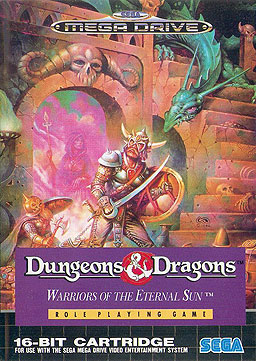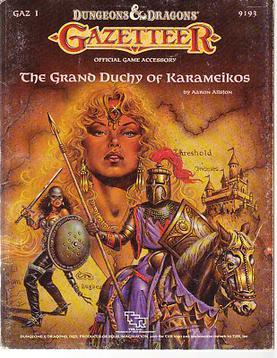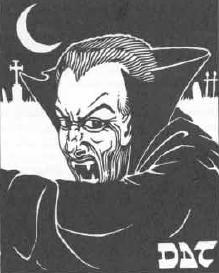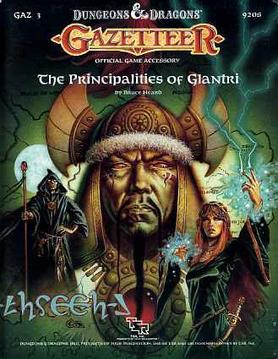
Mystara is a campaign setting for the Dungeons & Dragons fantasy role playing game. It was the default setting for the "Basic" version of the game throughout the 1980s and 1990s. Most adventures published for the "Basic" edition of D&D take place in "The Known World", a central continent that includes a varied patchwork of both human and non-human realms. The human realms are based on various real-world historical cultures. In addition, unlike other D&D settings, Mystara had ascended immortal beings instead of gods.

Blackmoor is a fantasy role-playing game campaign setting generally associated with the game Dungeons & Dragons. It originated in the early 1970s as the personal setting of Dave Arneson, the co-creator of Dungeons & Dragons, as an early testing ground for what would become D&D.
Several different editions of the Dungeons & Dragons (D&D) fantasy role-playing game have been produced since 1974. The current publisher of D&D, Wizards of the Coast, produces new materials only for the most current edition of the game. However, many D&D fans continue to play older versions of the game and some third-party companies continue to publish materials compatible with these older editions.

Aaron Dale Allston was an American game designer and author of many science fiction books, notably Star Wars novels. His works as a game designer include game supplements for role-playing games, several of which served to establish the basis for products and subsequent development of TSR's Dungeons & Dragons game setting Mystara. His later works as a novelist include those of the X-Wing series: Wraith Squadron, Iron Fist, Solo Command, Starfighters of Adumar, and Mercy Kill. He wrote two entries in the New Jedi Order series: Enemy Lines I: Rebel Dream and Enemy Lines II: Rebel Stand. Allston wrote three of the nine Legacy of the Force novels: Betrayal, Exile, and Fury, and three of the nine Fate of the Jedi novels: Outcast, Backlash, and Conviction.
The flexibility of the Dungeons & Dragons (D&D) game rules means that Dungeon Masters (DM) are free to create their own fantasy campaign settings. For those who wanted a pre-packaged setting in which to play, TSR, Wizards of the Coast (WotC), and other publishers have created many settings in which D&D games can be based; of these, the Forgotten Realms, an epic fantasy world, has been one of the most successful and critically acclaimed settings. Many campaign settings include standard sword and sorcery environments, while others borrow Asian, Central American, swashbuckling, horror and even space-travel themes.

Dungeons & Dragons: Warriors of the Eternal Sun is a role-playing video game developed for the Sega Genesis in 1992 by Westwood Associates. The game tells the story of a party of adventurers who have been transported to an unknown world and must survive against its hostile inhabitants while learning about their new home and seeking allies. It is based on the Dungeons & Dragons (D&D) game rules, and uses creatures and themes from the D&D Hollow World campaign setting, such as Blacklore elves, the Azcans, beastmen, Malpheggi lizardmen, and dinosaurs.

The Grand Duchy of Karameikos is an accessory for the Basic Set edition for the Dungeons & Dragons fantasy role-playing game. The book was written by Aaron Allston, and was published in 1987. Cover art is by Clyde Caldwell, with interior illustrations by Stephen Fabian.

In the Dungeons & Dragons fantasy role-playing game, a vampire is an undead creature. A humanoid or monstrous humanoid creature can become a vampire, and looks as it did in life, with pale skin, haunting red eyes, and a feral cast to its features. A new vampire is created when another vampire drains the life out of a living creature. Its depiction is related to those in the 1930s and 1940s Hollywood Dracula and monster movies. In writing vampires into the game, as with other creatures arising in folklore, the authors had to consider what elements arising in more recent popular culture should be incorporated into their description and characteristics.

The Isle of Dread is an adventure for the Dungeons & Dragons role-playing game. The adventure, module code X1, was originally published in 1981. Written by David "Zeb" Cook and Tom Moldvay, it is among the most widely circulated of all Dungeons & Dragons adventures due to its inclusion as part of the D&D Expert Set. In the adventure, the player characters arrive on the Isle of Dread seeking a lost treasure, and there encounter new nonhuman races.

The Dungeons & Dragons Basic Set is a set of rulebooks for the Dungeons & Dragons (D&D) fantasy role-playing game. First published in 1977, it saw a handful of revisions and reprintings. The first edition was written by J. Eric Holmes based on Gary Gygax and Dave Arneson's original work. Later editions were edited by Tom Moldvay, Frank Mentzer, Troy Denning, and Doug Stewart.

The Dungeons & Dragons Rules Cyclopedia is a 1991 book published by TSR, Inc., as a continuation of the basic edition of the Dungeons & Dragons fantasy role-playing game, which ran concurrently with Advanced Dungeons & Dragons. Its product designation was TSR 1071.

The Principalities of Glantri is an accessory for the Basic Set edition of the Dungeons & Dragons fantasy role-playing game. It is part of the Gazetteer series of supplements for the Mystara campaign setting.

The Dungeons & Dragons Companion Set is an expansion boxed set for the Dungeons & Dragons (D&D) fantasy role-playing game. It was first published in 1984 as an expansion to the Dungeons & Dragons Basic Set.

Dungeons & Dragons Master Rules is an expansion boxed set for the Dungeons & Dragons (D&D) fantasy role-playing game. It was first published in 1985 as an expansion to the Basic Set.

Dungeons & Dragons Immortals Rules, written by Frank Mentzer, is a boxed set for the Dungeons & Dragons (D&D) fantasy role-playing game first published by TSR in 1986 as an expansion to the Basic Set.

The Expert Set is an expansion boxed set for the Dungeons & Dragons fantasy role-playing game. It was first published in 1981 as an expansion to the Basic Set.

Red Arrow, Black Shield is an adventure module for the Dungeons & Dragons fantasy role-playing game. It was published by TSR in 1985, and designed by Michael S. Dobson. Its cover art is by Jeff Easley, and cartography by Dennis Kauth. The module's associated code is X10 and its TSR product code is TSR 9160. This module was developed and intended for use with the Dungeons & DragonsExpert Set and Companion Set rules.

The Complete Priest's Handbook is a supplemental rulebook published in 1990 for the 2nd edition of the Advanced Dungeons & Dragons fantasy role-playing game. Accompanying manuals are The Complete Fighter's Handbook, Thief's Handbook, and Wizard's Handbook.

The Hollow World Campaign Set is an accessory for the Dungeons & Dragons fantasy role-playing game.
















